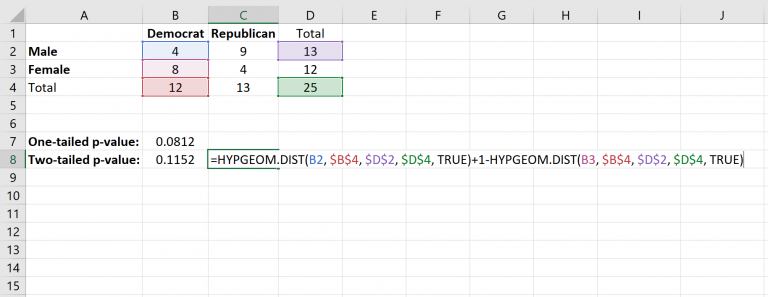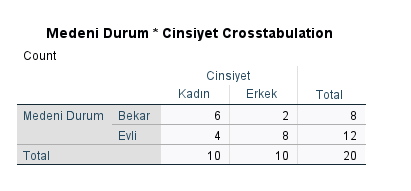4 Ways to Run Fisher's Exact Test in Excel

In the realm of statistical analysis, the Fisher's Exact Test is a powerful tool that allows researchers and analysts to assess the significance of associations between two categorical variables. This non-parametric test is particularly valuable when dealing with small sample sizes, where the assumptions of chi-square tests may not hold. Excel, a widely used spreadsheet software, provides several methods to perform Fisher's Exact Test, enabling users to analyze their data without the need for specialized statistical software.
Understanding Fisher’s Exact Test

Fisher’s Exact Test is a statistical procedure named after its creator, Sir Ronald Fisher. It is designed to calculate the exact probability of obtaining the observed or more extreme results, given the null hypothesis of independence between the two categorical variables. Unlike the chi-square test, which relies on an approximation, Fisher’s Exact Test provides an exact p-value, making it a preferred choice for precise analysis.
The test is particularly useful when the data is sparse or when the sample size is small. It is commonly used in fields such as medical research, genetics, and social sciences, where precise analysis of associations is critical.
Methods to Run Fisher’s Exact Test in Excel

Excel, with its robust suite of statistical functions, offers several ways to perform Fisher’s Exact Test. Here are four methods, each with its own advantages and considerations.
Method 1: Using the FISHERTEST Function
The FISHERTEST function in Excel is a straightforward way to calculate the p-value for Fisher’s Exact Test. This function takes a single argument, the array of cell references that contains the contingency table data. The output is the one-tailed p-value, which can be used to determine the significance of the association.
For example, if the contingency table data is in the range A1:B2, the formula would be: =FISHERTEST(A1:B2). This function is easy to use and provides a quick way to obtain the p-value.
Method 2: Creating a Custom Function
For more complex analyses or for users who prefer a custom approach, creating a user-defined function in Excel’s Visual Basic for Applications (VBA) can be beneficial. This method allows users to specify the exact calculations and logic for Fisher’s Exact Test.
The VBA code for Fisher's Exact Test involves defining the function, setting the arguments, and implementing the Fisher's Exact Test algorithm. While this method requires some programming knowledge, it offers flexibility and the ability to tailor the test to specific needs.
Method 3: Utilizing Add-Ins or Macros
Excel has a vast ecosystem of add-ins and macros that can extend its functionality. Several third-party developers have created add-ins specifically for statistical analysis, including Fisher’s Exact Test. These add-ins often provide a user-friendly interface and additional features, making it easier to perform complex analyses.
Users can search for "Fisher's Exact Test add-in for Excel" to find suitable options. Some popular add-ins include XLSTAT and Real Statistics, which offer a range of statistical tools, including Fisher's Exact Test.
Method 4: Online Tools and Web Applications
In addition to Excel’s built-in functions and add-ins, there are several online tools and web applications that can perform Fisher’s Exact Test. These tools often provide a simple interface, allowing users to input their data and obtain the results without the need for complex calculations.
Websites like GraphPad, Socscistatistics, and Statology offer free online calculators for Fisher's Exact Test. These tools can be particularly useful for quick analyses or for users who prefer a web-based interface.
Considerations and Best Practices
When using Excel for statistical analysis, it’s important to consider the following best practices and limitations:
- Data Entry: Ensure that the data is entered correctly and that the contingency table is formatted properly. Mistakes in data entry can lead to inaccurate results.
- Sample Size: Fisher's Exact Test is most appropriate for small sample sizes. For larger datasets, other statistical tests like chi-square may be more suitable.
- Significance Level: Choose an appropriate significance level (typically 0.05) and interpret the p-value accordingly. A low p-value indicates a significant association between the variables.
- Two-Tailed vs. One-Tailed: Fisher's Exact Test provides a one-tailed p-value by default. If a two-tailed test is required, the p-value can be doubled to obtain the two-tailed probability.
Conclusion
Excel’s versatility and its range of statistical functions make it a powerful tool for data analysis, including the implementation of Fisher’s Exact Test. By understanding the different methods available and their advantages, users can choose the approach that best suits their needs and data requirements. Whether through built-in functions, custom VBA code, add-ins, or online tools, Excel provides a flexible platform for statistical exploration.
What is Fisher’s Exact Test used for?
+Fisher’s Exact Test is used to assess the significance of associations between two categorical variables, particularly in cases where the sample size is small or the data is sparse.
Is Excel suitable for advanced statistical analysis?
+While Excel is versatile and offers a range of statistical functions, it may not be the best choice for highly complex or advanced statistical analyses. For such cases, specialized statistical software like SPSS or R is often recommended.
Can I use Fisher’s Exact Test for large datasets?
+Fisher’s Exact Test is most suitable for small sample sizes. For larger datasets, alternative tests like the chi-square test or more advanced statistical methods may be more appropriate.



